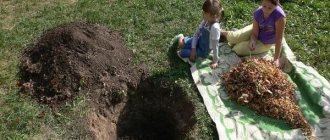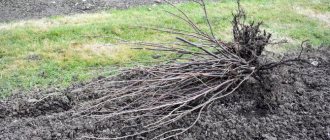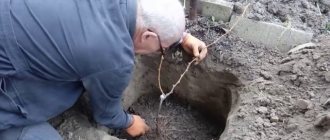5294
The flowering period of peonies is a wonderful time for any garden, regardless of whether there is just one bush or a collection with many varieties. This culture is distinguished by its richness of colors and lush flowering, but in order to maintain the luxurious appearance of the shrub for many years, you need to know exactly when to replant peonies and how to care for them annually.
Peonies grow in one place for over 20 years
Why is a transplant needed?
The best period for replanting is autumn
One of the features of peonies is their fragile, deep-lying root system. Therefore, culture transplantation is painful. After this procedure, the divisions take a long time to recover, and often begin to bloom only after 2-3 years.
It is important to know when to repot peonies and how to do it carefully while minimizing stress to the plants. It is impossible to do without this procedure. Upon reaching the age of 6-7 years, the bushes begin to produce less lush flowering, the flowers become smaller. Sometimes they stop appearing altogether. This is explained by the fact that the roots thicken and suffer from nutrient deficiency.
Thickening of the root system
The root system of an adult plant looks like a dense plexus of thick roots forming nodes. They are often empty and rotten on the inside. Underground parts often become a haven for rodents, which make passages and burrows inside. As a result, root growth slows down significantly, and the green mass stops developing, not receiving sufficient nutrition.
Important! Old bushes lose strength, do not reproduce, and therefore lose the ability to throw out buds. Flowering stops altogether or becomes scarce.
When the root system thickens and the crop stays in the same place for a long time, soil depletion occurs. Plants begin to suffer from a deficiency of essential microelements.
Fertilizing, which is usually applied to young bushes during planting, lasts for several years. Then the peonies are fertilized every year, but this does not allow them to fully satisfy their needs for nutrients, since the crop receives the bulk of them from the soil.
The root system of peonies is located deep under the surface of the earth, does not spread to the sides, and the fertile layer lies at a depth of about 20 cm. Therefore, the roots cannot absorb the required amount of microelements, the plants do not have enough strength for active growth and frequent flowering.
When is the best time to divide bushes for replanting?
Peonies are divided and replanted from the second half of August to the first half of September. If you decide to replant peonies, you need to take care and dig holes for the plants in advance. This is done in early July to compact the soil.
A small amount of mineral fertilizers of the phosphorus and nitrogen group is added to the holes. If peonies are fed with bone meal, adding 300 g of fertilizer per 1 m², then in the next 2-3 years the plants will not need any additional feeding.
When choosing the time to transplant bushes, it is necessary to take into account that the roots of the plant must be fully formed and take root in the new place, giving off small shoots. From the second half of September, peonies should be left alone, and it is better to divide the bushes and replant them in the spring. Otherwise, the roots of bushes planted at the end of September will not have time to take root and will die from frost.
When is the best time to replant plants in the fall, you should check the lunar calendar. Peonies are transplanted during the waxing moon. If the bushes are replanted in the fall, the plant will bloom next spring. When replanting a peony in the spring, the plants will be sickly and will bloom only after a season.
Choosing a new place
Culture does not like strong winds and drafts
When to replant primrose - in spring, summer or autumn
The main requirement that a new site must meet is good lighting. Peonies are a light-loving crop. They can grow in light partial shade. But if they remain in dense shade, for example, from trees or buildings, for at least 1 hour a day, then flowering worsens and the bushes wither.
- The future flower bed with peonies should be ventilated so that the plants are not affected by fungus.
- Close proximity to buildings is not recommended because in the summer heat, brick or concrete walls reflect heat. This may burn the plants.
- And nearby shrubs or trees can deprive peonies of nutrients and water.
Therefore, when deciding when to transplant peonies to another place, it is important to pay attention to the selection of the site. It is better to leave a central place for them in the garden or in a flower bed, so that trees and buildings do not block the bushes from the light.
The crop does not have such high demands on soil composition. She feels comfortable on any garden soil. Drained loamy soil is considered the best option.
Note! Peonies love good moisture, but do not tolerate stagnant moisture. Their root system begins to rot.
The soil for normal root development must be soft, thoroughly and deeply cultivated, otherwise the root system will remain in the top layer of soil. In summer it dries out quickly, which threatens the bushes with a lack of moisture, slower growth, and lack of flowering. If the soil in the new area for peonies is poor, it must be enriched with fertilizers.
Main mistakes when transplanting peonies
When transplanting flowers, many inexperienced gardeners make many unforgivable mistakes. Among the main ones:
- very rare transplantation or its complete absence;
- non-compliance with the rules of digging (digging only on one side, pulling by the ground parts of the bush);
- wrong choice of location, planting in a shaded, dense area.
In the first year after transplantation, all buds that appear on the bushes must be cut off. The absence of flowering will help the still fragile root system to quickly take root and recover from the stress suffered.
Important!
Flowers should not be planted close to fences. The optimal distance from them is 1.5-3 m.
Features of planting at different times of the year
Healthy and intact suction roots are the key to successful establishment of young plants
How to feed peonies at the dacha in autumn and spring
To determine how to plant peonies and when to do it, you need to have an idea of the characteristics of their root system.
- Its central, most massive part serves as a kind of storehouse for nutrients. It is this that supports the plant during wintering and protects it from the cold.
- Thinner processes extend from it. The density and abundance of flowering bushes depend on their condition, since replacement buds and young stems are formed on these roots. Sprouts in the form of light, thin root shoots are formed in the fall, in September.
- Another important part of the root system is the suction shoots, which can be thought of as a thin web that collects micronutrients and moisture. To avoid damaging it, when planting peonies it is necessary to prepare a wide and deep hole.
To choose the right moment when you can replant peony bushes, you need to know the peculiarities of crop adaptation at different times of the year.
in spring
Transplanting peonies in spring has one significant drawback: it is easy to be late with this work.
With the end of winter, the plants wake up. There is a rapid growth of suction roots. If you start replanting the bush during this period, these roots can be damaged, which threatens the death of the entire plant. It will not receive nutrition and will quickly use up the reserve that has accumulated in the massive central roots.
Important! Bushes that have been transplanted in the spring often become overgrown with a thick green mass. But next winter they do not survive, since over the summer their storehouse of useful substances is used up, and there is not enough for the winter.
If you still replant the bushes after wintering, then this should be done as early as possible, immediately after the snow cover melts, before the plants awaken. By this time, the roots do not have time to wake up. They begin to develop in a new area.
In summer
In June and July, the crop actively grows green mass, and the suction roots have time to grow and gain a foothold in the soil in the spring. Their development slows down, but the roots actively extract moisture and nutrients. When buds form on the bushes, the main forces of the plant are directed to the flowers.
If you replant peonies in the summer, the suction roots will inevitably be damaged and the nutrition of the bushes will deteriorate. In the new area, neither the development of new roots nor the adaptation of old ones occurs. The only source of nutrition is the reserves already made by the plants. But there are not enough of them for wintering, which often leads to the death of peonies.
According to statistics, most bushes transplanted in summer wither within a month
in autumn
In autumn, peonies stop blooming and begin to prepare for winter. The green mass is not growing. Plants store nutrients. Their absorbent roots actively extract nutrients and grow quickly. This period is considered the best time to plant peonies. The bushes are ready to be divided and moved to a new site. The roots are ready for the winter cold.
One month is enough for the culture to take root normally. Before frost sets in, peonies have time to grow suction roots. In the northern regions, planting can be done as early as mid-August. In the middle zone, the optimal time is in September, and in the south it lasts until mid-October.
Note! When replanting bushes in the fall, it is important not to be late.
On average, at the end of September there begins a period of active growth of storage roots, where plants retain a supply of necessary elements. They become denser and more voluminous. The transplant must be carried out before this time, otherwise the bush will not survive the winter.
When is it better to replant peonies, in spring or autumn?
It is recommended to replant peonies once every 5-6 years. It is best to do this at the end of the spring-summer season. The optimal period is September-October, before frosts begin. In the Moscow region, work can begin at the end of August.
When choosing the most suitable time for replanting plants, it is necessary to take into account the climatic conditions of the region and the weather. So, in the north of the country, where it is noticeably colder, this is done earlier, in the southern regions - later.
Preparing the site for transplantation
How to propagate peonies for planting in spring and autumn
You need to start preparing a flower bed for peonies 2-4 weeks before the planned planting date, so that the soil settles and compacts. Planting pits are prepared for the crop.
- Their width and depth should be about 0.5 m.
- The bottom is thoroughly loosened.
- Before planting, a mixture of humus and garden soil is poured into the hole with the addition of 200 g of superphosphate and 500 g of bone meal.
If the site is located in a lowland, then the flower beds must be raised and a drainage layer must be installed in the planting holes. To do this, they should be deepened by 20 cm and filled with coarse sand and gravel.
Some gardeners use the trench method when planting peonies. When it becomes necessary to transplant a large number of plants, instead of individual holes, they dig trenches 0.5 m wide and deep.
Technology for transplanting peony bushes in autumn
Peonies develop well in open, well-lit areas, protected from sharp gusts of wind, but with good circulation of air masses. The most preferable area would be one that is slightly shaded during the hot afternoon hours. These flowers grow best on permeable, loose and fertile soils with a close to neutral alkaline reaction (PH no higher than 6–6.5).
Peonies love well-lit sunny places
The place for planting peonies should be prepared in advance, about 2-3 weeks, so that the ground settles:
- A hole is dug 0.6*0.6 m in size and 0.7–0.8 m deep.
The hole for the peony should be large enough, as its roots grow greatly
Holes for small peonies are made at a distance of 0.8–1 m from each other
Drainage made of stones, pebbles, broken bricks, etc. is laid at the bottom of the pit.
The planting hole is filled 2/3 with soil mixture
The soil mixture in the planting hole is spilled abundantly with water.
For planting, use purchased seedlings or divide existing mother peony bushes:
- All stems are shortened to 10–15 cm.
Before transplanting, you need to shorten the peony stems
First, the peony bush is dug around the perimeter
Peony bush removed from the ground
The dug up peony bush is left to lie in the shade so that it wilts a little and the roots become less fragile
The peony bush is divided into parts using a sharp knife
First, the rhizomes are disinfected in a strong solution of potassium permanganate
Then the peony rhizomes are soaked in a root formation stimulator solution
Next, proceed directly to planting:
- The seedling is placed in the prepared hole. It is necessary to ensure that the growth buds are 3–5 cm below ground level. Excessive deepening is dangerous due to increased leaf growth and poor flowering; if they are close to the soil surface, the renewal buds may freeze out.
We position the peony bush so that the buds are 3–5 cm below ground level
We carefully straighten the roots and lay them out along the bottom of the hole.
Holding the bush suspended, we fill the planting hole with soil.
The soil in the pit must be compacted well to prevent voids from forming.
After planting, the seedling needs to be watered well.
Peony is mulched with humus or peat
Planting tree peonies is carried out in a similar way, with the only difference being that the root collar is buried a little lower (8–10 cm from the soil level).
How to dig up peonies correctly
When replanting, it is necessary to preserve the integrity of the massive roots, which retain a supply of nutrients, as well as young root growths containing buds.
Stages of work:
- Dig up the plant at a distance of 40-50 cm from the outer branches. To do this, use a pitchfork.
- Take a bayonet shovel and carefully move the lump with the plant, lifting it up. This should be done slowly so as not to injure the fragile root system. You cannot pull it out of the ground by holding onto the branches.
- Trim the stems so that their length is approximately 10 cm.
- Rinse the dug up roots with water to understand how to separate them.
- Leave the planting material to dry for several hours in a shaded place so that the roots become elastic and do not crack.
How to split
Each division must have:
- thick root area;
- several young shoots;
- from 3 to 5 healthy kidneys.
Note! If only one bud remains on the cutting, this does not harm the peony, but its flowering is delayed for several years. If there are too many buds, the root system can weaken.
After pruning, the division must be carefully inspected. It must not be damaged. If there are rotten or dried areas on it, they should be removed.
Sprinkle the cut areas with activated carbon.
How to dig up a bush correctly
Having studied the conditions, how to plant a peony bush and when to choose the best period for this, gardeners dig up the plants in August or September. For a large bush, a reliable tool is a fork, which will not cut off the ends of large roots. Absorbing web-like shoots penetrate to a depth of 90 cm. When replanting, it is almost impossible to save all of these roots, but cutting large rhizomes with a shovel can cause them disease.
When to prune peonies after flowering
Follow the operating algorithm:
- They dig up the bushes, retreating at least 40 cm, to approximately the same depth.
- They loosen a clod of earth with roots.
- They try to get it out with two shovels.
- Wash the rhizome from the ground and cut the stems to 10 cm.
Place the dense root ball in the shade so that the large intertwining shoots move slightly apart from each other under their own weight. After a few hours, the old peony bush is divided.
Additional Information! Before dividing the rhizomes of peonies, choose a sharp knife and disinfect the blade with potassium permanganate, brilliant green or an alcohol solution so as not to accidentally introduce an infection.
Step-by-step instructions for landing in a new place
A rail is placed across the planting hole. It serves as a reference point for measuring the distance to which the buds need to be buried. For tree peonies, they should be located at the same level with the ground surface; for herbaceous varieties, 4 cm is enough. Excessive deepening leads to the fact that the crop does not flower, and insufficient deepening leads to freezing in winter.
Peonies should be planted as follows:
- Focusing on the staff, the seedlings are lowered into the planting hole.
- Sprinkle it.
- Water and add soil again.
- The tree trunk circle is mulched with sawdust or peat.
Planting and caring for peonies
- Planting: late August or early September.
- Flowering: May.
- Lighting: bright sunlight in the first half of the day, then bright diffused light or light partial shade.
- Soil: slightly acidic loam.
- Watering: infrequent, but plentiful: 2-3 buckets of water for each adult bush.
- Feeding: the first feeding is carried out in early spring, and from the second week of May, peonies are treated with a solution of mineral or organic fertilizer every month, leaves at a time.
- Reproduction: root cuttings and seeds (rarely).
- Pests: bronze beetles, turf ants, root-knot nematodes.
- Diseases: gray rot, rust, brown spot, septoria, root rot, viral mosaic.
Read more about growing peonies below.
flower (lat. Paeonia) is a monotypic genus of herbaceous perennials, the only one in the Peony family. There are herbaceous types of peonies, tree peonies, and also types that combine the properties of both tree and herbaceous peonies - about forty species in total. In nature, peony flowers grow in the temperate and subtropical zones of North America and Eurasia. Cultural cultivation of peonies began in China during the Han era, more than two thousand years ago. The peony flower is named after the legendary healer Pean, who saved both gods and people from mortal wounds received in battles. In our gardens, we mainly grow herbaceous peony, highly valued by gardeners for the beautiful fragrant buds that decorate the flowerbed from May for a month and a half. Our story will be about these peonies.
Further care
Caring for peony seedlings includes several agrotechnical operations:
- Watering. In autumn it is moderate, taking into account precipitation. During the first month after the bush has been transplanted, it is watered no more than 3 times. In spring, water procedures are carried out more often.
- Loosening, weed removal, mulching. By adding a layer of mulch, gardeners reduce moisture evaporation and prevent weeds from appearing.
- Preparing for winter. To insulate the roots, they are sprinkled with a layer of peat, sawdust or spruce branches 15 cm or more thick.
- Prevention. In spring, seedlings are sprayed to protect them from insect attacks and diseases.
If you transplant peonies in the right way, the first flowers will appear on young plants next year. You should not leave them on the bushes so that the peonies do not waste energy and better survive the winter. In the second year, one flower is allowed to bloom. Full flowering begins in the third year.
Separation
When to prune peonies after flowering
The rhizomes of powerful old bushes are tightly intertwined. Therefore, when dividing, they are first measured approximately so that there are 3-5 buds on the segments. Bushes that are too overgrown are divided by driving a wedge into the center of the coma. They work with the roots carefully, despite their impressive appearance they are quite fragile. They try not to cut off such a fragment where there are many buds and few roots. The plant will not be able to fully feed due to the small volume of the root system.
Adhere to the requirements for healthy divisions:
- root length – 8-15 cm;
- there are at least 3-4 buds, but no more than 6-8;
- 3-5 thin shoots extend from the rhizome, up to 8-10 mm thick, up to 4-6 cm long.
The roots are cut with a sharp knife, following the direction from top to bottom. After separation, the sections are reviewed to discard those showing signs of disease or major damage. Rotten roots are cut off, treating fresh surfaces, like the entire lump, with copper-based compounds: Bordeaux mixture, copper oxychloride or other preparations. Then the sections are dusted with wood ash. The planting material dries for 24 hours in a dry, shady corner. To avoid the appearance of rot, rhizomes are disinfected in a pink solution of potassium permanganate. If desired, gardeners treat sections of peony rhizomes in a solution of any growth stimulator, following the instructions for the drug.
Transplanting peonies
Undivided bushes do not take root well, so too old rhizomes are cut out from the central part of the coma. In addition, these parts may be rotten or hollow inside. The sections are also processed. You can also plant small sections of roots that have 1-2 buds. Experienced gardeners do not refuse fragments without buds. If there are small, strong roots, the peony will grow into a flowering bush with proper care in a few years. The buds wake up if the rhizome is in good conditions.
Such different peonies...
These perennial plants belong to the Ranunculaceae family and are divided into two main types: tree-like, retaining the aboveground part throughout the year, and herbaceous, with foliage dying off in autumn. In Russian gardens, herbaceous peonies are most widespread, blooming from May to the end of June. These plants with large, strongly dissected leaves can reach a height of up to 100 cm and have a fleshy, powerful rhizome. At the ends of the stems there are simple semi-double or double flowers. Their coloring can be very diverse.
According to the structure of the flower, peonies are divided into:
- anemone-shaped;
- terry;
- semi-double;
- non-double;
- Japanese.
Types and varieties of peonies
According to the structure of the flower, peonies are divided into 7 groups:
Non-double
They have one or two rows of petals. The flowers are large, there are numerous stamens in the center of the flower, the leaves are sometimes corrugated (for example, varieties Golden Glow, Nadya);
Semi-double
Very large, light flowers; the stamens are located either in the center of the flower or between the petals. The flower usually has seven rows of petals. Varieties:
- Miss America is a mid-early variety, a pink flower 25 cm in diameter turns white after opening, the stamens are bright yellow;
- Ann Berry Cousins - an early variety of coral-pink color, cup-shaped flower 17 cm in diameter, bush up to 65 cm tall;
In the photo: Non-double peonies
Japanese
The modified stamens in the center of the flower form a pompom; the petals in the flowers can be in one or several rows. Varieties:
- Carrara is a medium-flowering white variety, 16 cm in diameter, bush height – 80 cm;
- Hot Chocolet is a mid-early peony of dark burgundy color, 16 cm in diameter, height up to 80 cm;
Anemoneaceae
A transitional form from Japanese peonies to the group of double peonies. The lower petals are wide, rounded, arranged in two rows, the central petals, shorter, form a ball. Varieties:
- Rhapsody is a mid-early variety, the marginal petals are pink, the central petals forming a ball are yellow-cream, flower diameter is 16 cm, bush height is 70 cm;
- Snow Mountain – early cream-colored peony, 17 cm in diameter, height – 75 cm;
Terry hemispherical, bomb-shaped, spherical
The petals of the flower are collected in a hemisphere and, when fully opened, form a ball. Varieties:
- Pink Cameo - a medium-late variety of creamy pink color, 16 cm in diameter, bush 80 cm in height;
- Monsieur Jules Ely - an early fragrant variety of lilac-pink color, diameter - 20 cm, height - 90 cm;
In the photo: Semi-double peonies
Rosaceae
The petals of a flower, very similar in structure to a rose, are the same in size, round, wide, large. Varieties:
- Solange is a late creamy-white peony 17 cm in diameter, the height of heavy stems that need support reaches 70 cm;
- Henry Boxtox is an early variety of bright red color, 16 cm in diameter, bush 90 cm tall.
In the group of pink peonies there is a subgroup of semi-rose peonies, which are distinguished by the presence of an island of stamens in the middle of the flower. Varieties:
- Gudi – mid-early, bright crimson, 16 cm in diameter, height – 70 cm;
- Ballerina is an early variety of white-cream-green color, a powerful bush, flower diameter is 18 cm.
Crown hemispherical and spherical
Flower petals are arranged in three tiers: the upper tier is a ring of petals, the middle one consists of petals that are narrower than those on the upper and lower tier. As a rule, the top and bottom rows are the same color, the middle row may differ in color. Varieties:
- Nancy is an early variety of pink-peach color, 17 cm in diameter, bush up to 80 cm tall;
- Aritina Nozen Gloria is a very early variety of pink-lilac hue, bush height - 70 cm, flower diameter - 20 cm.
Feeding and watering
If you take proper care, beautiful and lush peonies will bloom in your flowerbed or garden in the spring. Replanting in the fall is a very important aspect. During this period, the plant takes root as much as possible and has a better chance of producing abundant flowering in the spring.
Peonies in the summer, especially in extreme heat, need to be watered regularly. It is best to do this not on the leaves, but at the root.
When flowers are just planted, they should not be fertilized in the first year. The soil has enough minerals. Already in the second and third years of life, peonies need to be fed with nitrogen-containing fertilizers. For example, urea or crystalline, mullein solution or a pinch of boron.
If you carry out proper care and replanting of peonies, then every year the flowerbed will be full of large and bright flowers.











